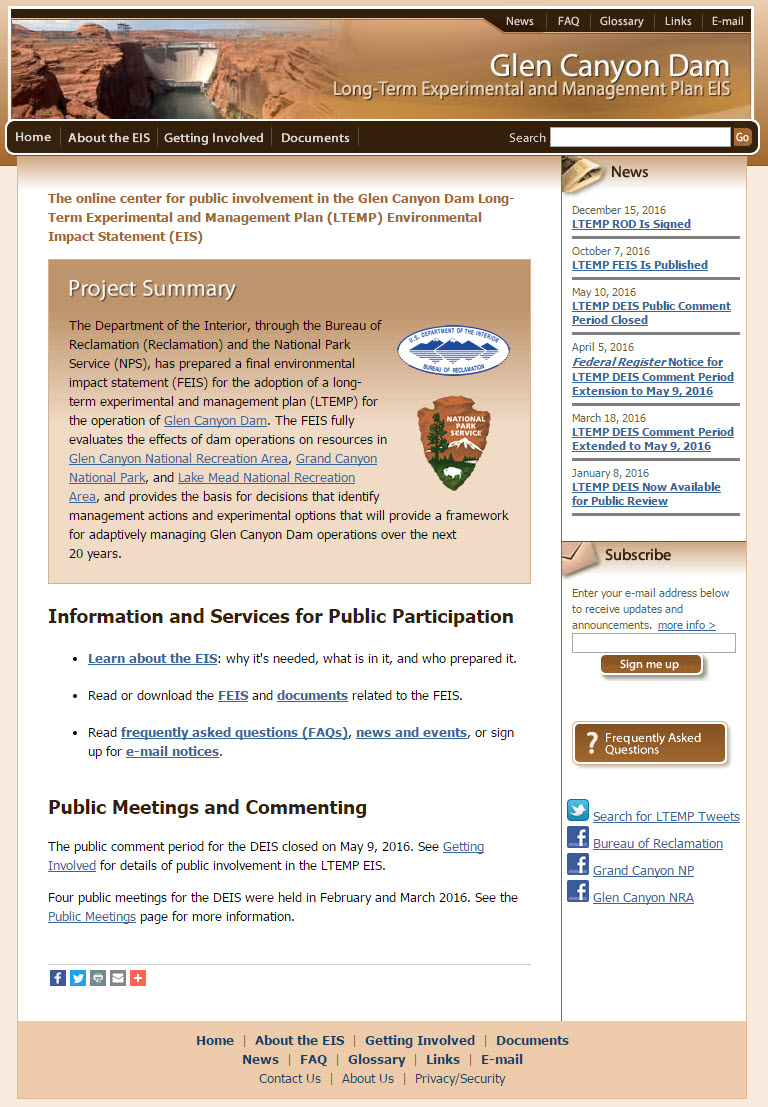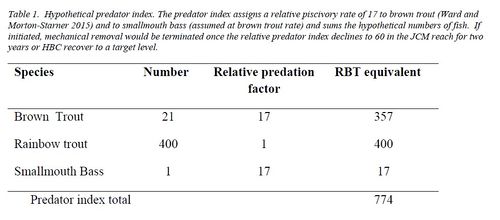Difference between revisions of "Long-term Experimental and Management Plan (LTEMP)"
Cellsworth (Talk | contribs) |
Cellsworth (Talk | contribs) |
||
| Line 411: | Line 411: | ||
*[[Media:20240500-GCDLTEMP-FinalSEIS-508-AMWD_(2).pdf| 2024 Glen Canyon Dam Long-Term Experimental and Management Plan Final Supplemental Environmental Impact Statement (SEIS)]] | *[[Media:20240500-GCDLTEMP-FinalSEIS-508-AMWD_(2).pdf| 2024 Glen Canyon Dam Long-Term Experimental and Management Plan Final Supplemental Environmental Impact Statement (SEIS)]] | ||
| − | *[https://www.usbr.gov/uc/DocLibrary/EnvironmentalImpactStatements/GlenCanyonDamLong-TermExperimentalManagementPlan/20240703-GCDLTEMP-FinalSEIS-RecordofDecision-508-AMWD.pdf Record of Decision for the Glen Canyon Dam Long-Term Experimental and Management Plan (LTEMP) Final Supplemental Environmental Impact Statement (SEIS) ] | + | *[https://www.usbr.gov/uc/DocLibrary/EnvironmentalImpactStatements/GlenCanyonDamLong-TermExperimentalManagementPlan/20240703-GCDLTEMP-FinalSEIS-RecordofDecision-508-AMWD.pdf 2024 Record of Decision for the Glen Canyon Dam Long-Term Experimental and Management Plan (LTEMP) Final Supplemental Environmental Impact Statement (SEIS) ] |
*[https://www.usbr.gov/uc/progact/amp/ltemp.html Reclamation Long-term Experimental and Management Plan (LTEMP) website] | *[https://www.usbr.gov/uc/progact/amp/ltemp.html Reclamation Long-term Experimental and Management Plan (LTEMP) website] | ||
*[http://ltempeis.anl.gov/ Argonne Long-term Experimental and Management Plan (LTEMP) website] | *[http://ltempeis.anl.gov/ Argonne Long-term Experimental and Management Plan (LTEMP) website] | ||
| − | + | *[http://ltempeis.anl.gov/documents/docs/LTEMP_ROD.pdf 2016 LTEMP Record of Decision (ROD)] | |
| − | *[http://ltempeis.anl.gov/documents/docs/LTEMP_ROD.pdf Record of Decision (ROD)] | + | *[[Media:2018 LTEMP HPP.pdf| 2018 Historic Preservation Plan (HPP) ]] |
| − | *[[Media: | + | *[[Media:2017 LTEMP Final PA.pdf| 2017 Programmatic Agreement (PA)]] |
| − | *[[Media: | + | *[https://pubs.er.usgs.gov/publication/ofr20171006 2017 LTEMP Science Plan ] |
| − | *[ | + | *[http://ltempeis.anl.gov/documents/final-eis/ 2016 LTEMP EIS Final Draft (FEIS)] |
| − | *[http:// | + | |
*[https://www.usbr.gov/uc/rm/amp/twg/mtgs/17apr20/Attach_04a.pdf Appendix D Draft Final: Proposed Action Triggers for the Management of Humpback Chub, Colorado River, Grand Canyon November 2015] | *[https://www.usbr.gov/uc/rm/amp/twg/mtgs/17apr20/Attach_04a.pdf Appendix D Draft Final: Proposed Action Triggers for the Management of Humpback Chub, Colorado River, Grand Canyon November 2015] | ||
| − | *[ | + | *[http://ltempeis.anl.gov/documents/final-eis/vol3/Appendix_O-Biological_Assessment.pdf 2016 LTEMP Biological Assessment (BA)] |
| + | *[http://www.riversimulator.org/Resources/USBR/LTEMP/FEIS/BiologicalOpinionGCD2016.pdf 2016 LTEMP Biological Opinion (BO)] | ||
*[http://gcdamp.com/index.php?title=Portal:Desired_Future_Conditions_-DFCs 2012 Desired Future Conditions] | *[http://gcdamp.com/index.php?title=Portal:Desired_Future_Conditions_-DFCs 2012 Desired Future Conditions] | ||
*[https://www.usbr.gov/lc/region/programs/strategies.html 2007 Interim Guidelines for Lower Basin Shortages and Coordinated Operations for Lake Powell and Lake Mead] | *[https://www.usbr.gov/lc/region/programs/strategies.html 2007 Interim Guidelines for Lower Basin Shortages and Coordinated Operations for Lake Powell and Lake Mead] | ||
Revision as of 15:00, 28 August 2024
|
|
The Long-term Experimental and Management Plan (LTEMP)Glen Canyon Dam was authorized by the Colorado River Storage Project Act of 1956 and completed by the Bureau of Reclamation (Reclamation) in 1963. Below Glen Canyon Dam, the Colorado River flows for 15 miles through the Glen Canyon National Recreation Area, which is managed by the National Park Service (NPS). Fifteen miles below Glen Canyon Dam, Lees Ferry, Arizona, marks the beginning of Marble Canyon and the northern boundary of Grand Canyon National Park. The major function of Glen Canyon Dam is water storage and flood control. The dam is specifically managed to regulate releases of water from the Upper Colorado River Basin to the Lower Colorado River Basin to satisfy provisions of the 1922 Colorado River Compact and subsequent water delivery commitments, and thereby allow states within the Upper Basin to withdraw water from the watershed upstream of Glen Canyon Dam and utilize their apportionments of Colorado River water. Another function of Glen Canyon Dam is the generation of hydroelectric power. The Grand Canyon Protection Act of 1992 (Pub. L.102–575) (GCPA) addresses potential impacts of dam operations on downstream resources in Glen Canyon National Recreation Area and Grand Canyon National Park. The GCPA required the Secretary of the Interior to complete an EIS evaluating alternative operating criteria that would determine how Glen Canyon Dam would be operated "to protect, mitigate adverse impacts to, and improve the values for which Grand Canyon National Park and Glen Canyon National Recreation Area were established." The first EIS on Glen Canyon Dam operations was published in March 1995. The Preferred Alternative of the 1995 EIS (Modified Low Fluctuating Flow Alternative) was selected as the best means to operate Glen Canyon Dam in a record of decision (ROD) issued on October 9, 1996. In 1997, the Secretary adopted operating criteria for Glen Canyon Dam (62 FR 9447) as required by Section 1804(c) of the GCPA. Additionally, the GCPA required the Secretary to undertake research and monitoring to determine if revised dam operations were achieving the resource protection objectives of the final EIS and ROD. These provisions of the GCPA were incorporated into the 1996 ROD and led to the establishment of the Glen Canyon Dam Adaptive Management Program (GCDAMP), administered by Reclamation, and of the Grand Canyon Monitoring and Research Center within the U.S. Geological Survey (USGS). The LTEMP will be coordinated with the existing Glen Canyon Dam Adaptive Management Program. The GCDAMP includes a federal advisory committee known as the Glen Canyon Dam Adaptive Management Work Group (AMWG), a technical work group, a scientific monitoring and research center administered by the USGS, and independent scientific review panels. The AMWG makes recommendations to the Secretary concerning Glen Canyon Dam operations and other management actions to protect resources downstream of Glen Canyon Dam consistent with the GCPA and other applicable provisions of federal law. The decision by the Secretary to develop the Glen Canyon Dam Long-Term Experimental and Management Plan EIS is a component of its efforts to continue to comply with the ongoing requirements and obligations established by the GCPA and recommendations of the AMWG. Reclamation and NPS are joint-leads on the LTEMP EIS because Reclamation has primary responsibility for operation of Glen Canyon Dam and NPS has primary responsibility for managing the resources of the Grand Canyon National Park, Glen Canyon National Recreation Area, and Lake Mead National Recreation Area. [1] |
| Long-term Experimental and Management Plan (LTEMP) The LTEMP provides the basis for decisions that identify management actions and experimental options that will provide a framework for adaptively managing Glen Canyon Dam operations over the next 20 years |
LTEMP Science Plan The LTEMP Science Plan describes a strategy by which monitoring and research data in the natural and social sciences will be collected, analyzed, and provided to DOI, its bureaus, and to the GCDAMP in support of implementation of LTEMP. |
GCDAMP Strategic Plan The GCDAMP Strategic Plan (AMPSP) is a long-term plan drafted in August 2001 by GCDAMP and GCMRC participants that identifies the AMWG’s vision, mission, principles, goals, management objectives, information needs, and management actions. |
Strategic Science Plan The GCMRC Strategic Science Plan (SSP) identifies general strategies for the next 5 years to provide science information responsive to the goals, management objectives, and priority questions as described in the AMPSP and other planning direction approved by the AMWG. |
Core Monitoring Plan The GCMRC Core Monitoring Plan (CMP) describes the consistent, long-term, repeated measurements using scientifically accepted protocols to measure status and trends of key resources to answer specific questions. Core monitoring is implemented on a fixed schedule regardless of budget or other circumstances (for example, water year, experimental flows, temperature control, stocking strategy, nonnative control, etc.) affecting target resources. |
Monitoring and Research Plan The GCMRC Monitoring and Research Plan (MRP) specifies (1) core monitoring activities, (2) research and development activities, and (3) long-term experimental activities consistent with the strategies and priorities established in this SSP to be conducted over the next 5 years to address some of the strategic science questions associated with AMWG priority questions. |
Triennial Work Plan (TWP) The GCMRC Triennial Work Plan (TWP) identifies the scope, objectives, and budget for monitoring and research activities planned for a 3-year period. When completed, the triennial work plan will be consistent with the MRP. |
|---|
|

